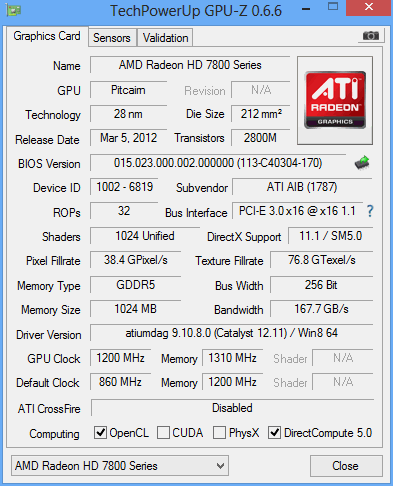System Builder Marathon, Q4 2012: $500 Gaming PC
Limited Overclocking Strikes Again
With no access to base clock settings, a locked ratio multiplier, and memory data rates fixed at 1333 MT/s, we were once again limited to pushing lower latencies as the only way to improve platform performance. Unlike our last effort, this ASRock board gives us a wealth of voltage adjustments. The memory defaulted to 1.585 V at the Auto setting. And, with just a small bump to 1.6 V, we found G.Skill's value kit stable at 7-8-7-22 1T timings.
I was also eager to see how far I could take PowerColor's retail Radeon HD 7850 above its stock 860 MHz core and 1200 MHz memory clocks. AMD's Overdrive applet offers sliders up to 1050/1450 MHz. But we also know that, last quarter, we were able to use MSI's Afterburner software to boost the voltage of our GeForce GTX 560, yielding a solid 950 MHz core and 1102.5 MHz clock rate. Hoping for the same great scalability, we chose to use something a little more enthusiast-class than Overdrive.
By default, the card's GPU voltage stuck at 1.138 V under 3D loads, and then dropped to 0.90 V in 2D mode. Messing with the memory clock rate in AMD Overdrive, MSI Afterburner, or Sapphire TriXX forced our GPU to a constant 1.138 V, regardless of what the card was doing, though. Only Asus' GPU Tweak utility could augment the GPU's voltage, enable functional core clock rates above 1050 MHz, and maintain separate 2D and 3D frequencies and voltages once overclocked.
PowerColor tunes its fan to stay very quiet. Throughout testing at stock clocks, it idled at a 20% duty cycle. At 30%, it kept the Pitcairn GPU from cresting 60 degrees while looping 3DMark11’s graphics tests. We're glad the cooler is so effective, though, because it gets pretty loud at higher rotational speeds. At an 1100 MHz core setting, and with the fan set to Auto, the GPU was running at 63 degrees with the fan at 31%. As soon as it hit 65 degrees, the fan jumped all the way to 41%. At that point, I set it to an intrusive 80%, just to figure out the core's maximum overclock.
Our GPUs was stable up to 1130 MHz at its stock voltage, and it broke past 1200 MHz after a bump to 1.205 V. That's an astounding 40% overclock! I had no intention of pushing the memory all the way to 1450 MHz, since we know there's a point where higher clocks won't translate to better performance. However, I was disappointed when artifacts started showing up at 1350 MHz. At the end of the day, we settled on a 1200 MHz core and 1310 MHz memory overclock.
Side note: ignore the driver version listed in GPU-Z. We tested using the Catalyst 12.10 build, but our screen shot was captured later, after the 12.11 build was installed.
Now, we'd never test with an overclock that required a screaming-loud fixed fan speed. But I was concerned the automatic settings would respond too slowly. So, I set up a user-defined fan profile in GPU Tweak to push more air any time the machine saw a 3D load. It took some tuning, but it worked flawlessly once everything was dialed in, idling quietly in 2D mode, ramping up to 33% shortly after entering a game, and keeping our overvolted and overclocked GPU from cresting 60 degrees between a 40 and 50% duty cycle. While my tuning may be considered loud by some folks, I prefer the stability that comes from pushing more air over an overvolted GPU compared to PowerColor’s fairly relaxed automatic settings.
Current page: Limited Overclocking Strikes Again
Prev Page Assembling Our Budget-Oriented Box Next Page Test System Configuration And BenchmarksGet Tom's Hardware's best news and in-depth reviews, straight to your inbox.
-
Crashman killerchickens$501 Plus $100 for a copy of windows 7.Run Linux, this is a hardware shootout.Reply
-
killerchickens CrashmanRun Linux, this is a hardware shootout.Reply
Linux for a gaming desktop I dont think so.
-
jerm1027 ReplyOur best alternative remained the quad-core Phenom II X4 995 Black Edition for $95. But we chose not to revisit this old favorite, figuring that adding a Radeon HD 7850 would have taxed our budget.
What about the Phenom II 965? It's only $75 at TigerDirect. -
EzioAs Reply9539399 said:I personally feel that they could have gone with H61 and gotten a 2GB 7850 instead.
I think they'd be better off with a B75 motherboard, 4GB RAM and an i3-3220. -
mayankleoboy1 I am not very comfortable using windows8 in these benches. Reason : Drivers have not yet matured for win8. I would have waited for the next quarter SBM before using win8.Reply -
killerchickens Windows is free and we use Linux in are gaming Machines what are we in Soviet Russia .Reply

